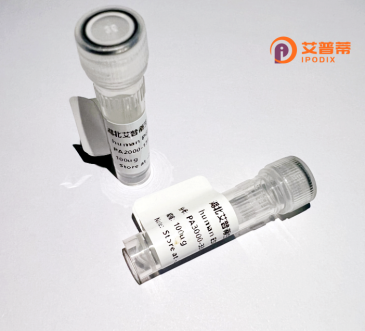
| 纯度 | >90%SDS-PAGE. |
| 种属 | Human |
| 靶点 | LEF1 |
| Uniprot No | Q9UJU2 |
| 内毒素 | < 0.01EU/μg |
| 表达宿主 | E.coli |
| 表达区间 | 1-399aa |
| 活性数据 | MPQLSGGGGGGGGDPELCATDEMIPFKDEGDPQKEKIFAEISHPEEEGDLADIKSSLVNESEIIPASNGHEVARQAQTSQEPYHDKAREHPDDGKHPDGGLYNKGPSYSSYSGYIMMPNMNNDPYMSNGSLSPPIPRTSNKVPVVQPSHAVHPLTPLITYSDEHFSPGSHPSHIPSDVNSKQGMSRHPPAPDIPTFYPLSPGGVGQITPPLGWQGQPVYPITGGFRQPYPSSLSVDTSMSRFSHHMIPGPPGPHTTGIPHPAIVTPQVKQEHPHTDSDLMHVKPQHEQRKEQEPKRPHIKKPLNAFMLYMKEMRANVVAECTLKESAAINQILGRRWHALSREEQAKYYELARKERQLHMQLYPGWSARDNYGKKKKRKREKLQESASGTGPRMTAAYI |
| 分子量 | 69.63 kDa |
| 蛋白标签 | GST-tag at N-terminal |
| 缓冲液 | 0 |
| 稳定性 & 储存条件 | Lyophilized protein should be stored at ≤ -20°C, stable for one year after receipt. Reconstituted protein solution can be stored at 2-8°C for 2-7 days. Aliquots of reconstituted samples are stable at ≤ -20°C for 3 months. |
| 复溶 | Always centrifuge tubes before opening.Do not mix by vortex or pipetting. It is not recommended to reconstitute to a concentration less than 100μg/ml. Dissolve the lyophilized protein in distilled water. Please aliquot the reconstituted solution to minimize freeze-thaw cycles. |
以下是3条关于重组人LEF1蛋白的参考文献及其摘要概括:
1. **"Functional analysis of recombinant human LEF1 in Wnt/β-catenin signaling"** - Müller et al.
*摘要*:该研究通过体外实验验证了重组人LEF1蛋白在Wnt信号通路中的转录调控作用,证实其与β-catenin结合后激活靶基因(如c-Myc)表达,促进肿瘤细胞增殖。
2. **"Production and purification of active recombinant human LEF1 for structural studies"** - Kim et al.
*摘要*:作者优化了大肠杆菌表达系统制备重组人LEF1蛋白的条件,通过亲和层析和凝胶过滤获得高纯度蛋白,并利用X射线晶体学解析其DNA结合域的三维结构。
3. **"LEF1 regulates colorectal cancer progression via epithelial-mesenchymal transition"** - Zhang et al.
*摘要*:研究发现重组人LEF1蛋白通过诱导上皮间质转化(EMT)增强结肠癌细胞迁移能力,其机制依赖于与Smad3的相互作用,提示LEF1可能成为癌症治疗靶点。
如需更具体文献,可补充研究场景或应用领域(如干细胞、癌症等)进一步筛选。
Recombinant human LEF1 (lymphoid enhancer-binding factor 1) protein is a key transcriptional regulator involved in the Wnt/β-catenin signaling pathway, which plays critical roles in embryonic development, cell differentiation, and tissue homeostasis. LEF1 belongs to the TCF/LEF family of DNA-binding proteins and acts as a nuclear mediator of Wnt signals by forming complexes with β-catenin to activate target gene expression. It contains a high-mobility group (HMG) domain for DNA binding and a context-dependent activation domain that interacts with β-catenin, enabling the transcription of genes regulating cell proliferation, survival, and fate determination.
Produced via molecular cloning and expression in systems like *E. coli* or mammalian cells, recombinant LEF1 retains functional domains essential for studying Wnt pathway mechanisms. Its applications span cancer research (e.g., studying Wnt-driven tumors), stem cell biology (maintaining pluripotency), and regenerative medicine. Researchers use it to dissect LEF1’s role in diseases, including colorectal cancer and osteoporosis, and to screen potential therapeutics targeting aberrant Wnt signaling. The purified protein also aids in structural studies and in vitro assays to map protein-DNA or protein-protein interactions, providing insights into developmental disorders and oncogenesis linked to LEF1 dysfunction.
×